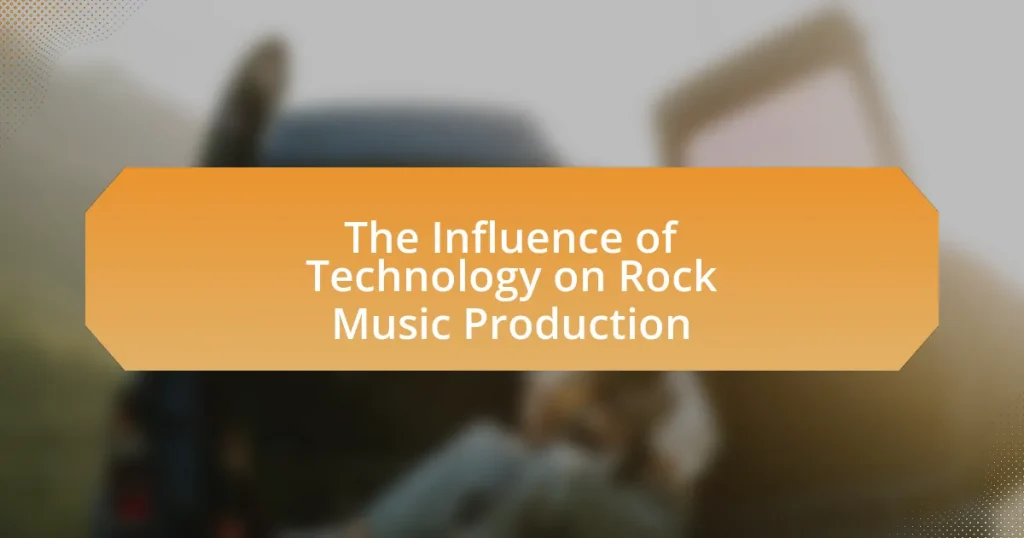The article examines the significant influence of technology on rock music production, highlighting advancements such as digital audio workstations (DAWs), multitrack recording, and synthesizers. It discusses how these technologies enhance sound quality, streamline production processes, and democratize music creation, allowing independent artists to produce high-quality recordings from home. Additionally, the article explores the evolving roles of producers and engineers, the impact of technology on the creative process, and the challenges faced by independent rock musicians in a tech-driven landscape. Key skills for modern musicians, as well as best practices for utilizing technology in production, are also addressed.

What is the Influence of Technology on Rock Music Production?
Technology significantly influences rock music production by enhancing sound quality, enabling innovative recording techniques, and facilitating music distribution. Digital audio workstations (DAWs) like Pro Tools and Logic Pro allow producers to manipulate sound with precision, leading to higher fidelity recordings. The introduction of synthesizers and electronic instruments has expanded the sonic palette available to rock musicians, allowing for new genres and styles to emerge. Additionally, advancements in technology have streamlined the mixing and mastering processes, making it easier for artists to achieve professional-quality results. The rise of online platforms for distribution, such as Spotify and Bandcamp, has transformed how rock music reaches audiences, allowing independent artists to share their work without traditional label support. These technological advancements have collectively reshaped the landscape of rock music production, making it more accessible and diverse.
How has technology transformed the production process in rock music?
Technology has significantly transformed the production process in rock music by introducing advanced recording techniques and digital tools. The advent of digital audio workstations (DAWs) has allowed musicians to record, edit, and mix tracks with unprecedented precision and flexibility. For instance, software like Pro Tools and Logic Pro enables multi-track recording and non-linear editing, which enhances creative possibilities and streamlines workflows. Additionally, the use of plugins and virtual instruments has expanded the sonic palette available to producers, allowing for a wider range of sounds and effects that were previously difficult or impossible to achieve. This shift towards digital production has democratized music creation, enabling independent artists to produce high-quality recordings from home studios, as evidenced by the rise of self-produced albums in the rock genre.
What are the key technological advancements that have impacted rock music production?
Key technological advancements that have impacted rock music production include multitrack recording, digital audio workstations (DAWs), and the use of synthesizers. Multitrack recording, introduced in the 1960s, allowed artists to record multiple audio tracks separately, enabling greater control over the mixing process and enhancing the complexity of rock music. Digital audio workstations revolutionized production in the 1990s by providing software platforms for recording, editing, and mixing music, which streamlined the production process and made it more accessible to independent artists. Additionally, synthesizers, which gained popularity in the 1970s, expanded the sonic palette available to rock musicians, allowing for innovative sounds and textures that shaped the genre. These advancements collectively transformed the landscape of rock music production, facilitating creativity and experimentation.
How do these advancements change the roles of producers and engineers?
Advancements in technology significantly alter the roles of producers and engineers by enhancing their capabilities and responsibilities in music production. Producers now leverage digital tools for composition, arrangement, and sound design, allowing them to take on more creative roles that were traditionally reserved for artists. Engineers, equipped with advanced software and hardware, can achieve higher sound quality and manipulate audio in ways that were previously impossible, such as real-time editing and mixing. This shift has led to a more collaborative environment where producers and engineers work closely with artists to realize their vision, utilizing technology to streamline workflows and enhance creativity. For instance, the use of digital audio workstations (DAWs) has revolutionized how music is recorded and produced, enabling more efficient processes and innovative sound exploration.
Why is understanding technology’s influence important for rock musicians?
Understanding technology’s influence is crucial for rock musicians because it directly impacts their creative process, production quality, and audience engagement. The evolution of recording techniques, such as the transition from analog to digital, has allowed musicians to experiment with sound in ways that were previously impossible, enhancing their artistic expression. For instance, the use of digital audio workstations (DAWs) has revolutionized how music is composed and produced, enabling artists to manipulate audio with precision and ease. Additionally, technology facilitates broader distribution through streaming platforms, which has changed how rock music reaches listeners, making it essential for musicians to adapt to these changes to remain relevant in the industry.
What skills do modern rock musicians need to adapt to technological changes?
Modern rock musicians need skills in digital audio production, social media marketing, and data analytics to adapt to technological changes. Proficiency in digital audio workstations (DAWs) like Pro Tools or Ableton Live allows musicians to create and manipulate music efficiently, reflecting the shift from analog to digital production methods. Additionally, understanding social media platforms is crucial for promoting music and engaging with fans, as these platforms have become primary channels for music distribution and marketing. Data analytics skills enable musicians to interpret streaming metrics and audience engagement, allowing them to make informed decisions about their music and marketing strategies. These skills collectively empower modern rock musicians to thrive in a rapidly evolving technological landscape.
How does technology affect the creative process in rock music?
Technology significantly enhances the creative process in rock music by providing tools that facilitate composition, recording, and production. Digital audio workstations (DAWs) allow musicians to experiment with sounds and arrangements more efficiently than traditional methods, enabling rapid iteration and innovation. For instance, the use of software like Pro Tools or Ableton Live has transformed how artists record and edit their music, allowing for complex layering and manipulation of audio tracks. Additionally, advancements in synthesizers and effects pedals have expanded the sonic palette available to rock musicians, encouraging experimentation with new sounds and styles. The integration of technology in rock music has led to the emergence of sub-genres and hybrid styles, showcasing its profound impact on creativity within the genre.

What are the specific technologies that have shaped rock music production?
The specific technologies that have shaped rock music production include multitrack recording, digital audio workstations (DAWs), and synthesizers. Multitrack recording, developed in the 1950s, allowed for the simultaneous recording of multiple audio tracks, enabling complex arrangements and layering of sounds. Digital audio workstations, which became prevalent in the 1990s, revolutionized music production by providing powerful software tools for editing, mixing, and mastering music. Synthesizers, introduced in the 1960s, expanded the sonic palette of rock music by allowing musicians to create a wide range of electronic sounds. These technologies collectively transformed the creative process and sound quality in rock music, leading to innovative genres and production techniques.
What role do digital audio workstations (DAWs) play in rock music production?
Digital audio workstations (DAWs) are essential tools in rock music production, enabling musicians and producers to record, edit, mix, and master audio tracks efficiently. DAWs provide a user-friendly interface that allows for the manipulation of multiple audio tracks simultaneously, facilitating complex arrangements typical in rock music. For instance, software like Pro Tools and Ableton Live offers features such as virtual instruments, effects processing, and automation, which enhance creative possibilities. The widespread adoption of DAWs has transformed the recording process, allowing for high-quality production in home studios, which has been a significant factor in the democratization of music creation since the early 2000s.
How do DAWs compare to traditional recording methods?
Digital Audio Workstations (DAWs) offer greater flexibility and efficiency compared to traditional recording methods. DAWs allow for non-linear editing, enabling musicians to easily manipulate audio tracks, apply effects, and arrange compositions without the constraints of physical tape or analog equipment. In contrast, traditional methods often require real-time recording and mixing, which can limit creative possibilities and increase production time.
Furthermore, DAWs typically provide a wide range of virtual instruments and plugins, enhancing sound design capabilities beyond what is achievable with conventional recording setups. According to a 2020 survey by the International Federation of the Phonographic Industry, over 70% of music producers now use DAWs as their primary tool, highlighting the shift towards digital production in the industry. This transition underscores the advantages of DAWs in modern rock music production, where speed, creativity, and accessibility are paramount.
What features of DAWs are most beneficial for rock music producers?
The most beneficial features of Digital Audio Workstations (DAWs) for rock music producers include multi-track recording, advanced editing capabilities, and a wide range of virtual instruments and effects. Multi-track recording allows producers to layer various instruments and vocals, essential for the complex arrangements typical in rock music. Advanced editing capabilities, such as quantization and pitch correction, enable precise manipulation of audio, ensuring that performances meet the desired standards. Additionally, a diverse selection of virtual instruments and effects, including guitar amp simulators and drum machines, provides rock producers with the tools necessary to create authentic sounds and textures. These features collectively enhance the production quality and creative possibilities in rock music.
How do recording techniques evolve with technology?
Recording techniques evolve with technology through advancements in equipment, software, and methods that enhance sound quality and production efficiency. For instance, the transition from analog tape to digital recording in the late 20th century allowed for greater precision, editing capabilities, and the ability to manipulate sound without degradation. Digital audio workstations (DAWs) like Pro Tools revolutionized the recording process by enabling multi-track recording, real-time editing, and the use of virtual instruments, which were not possible with earlier technologies. Additionally, innovations such as MIDI (Musical Instrument Digital Interface) and plugins have expanded creative possibilities, allowing musicians to experiment with sounds and effects that were previously unattainable. These technological advancements have continuously shaped the way rock music is produced, leading to a more polished and diverse sound.
What are the most common recording techniques used in modern rock music?
The most common recording techniques used in modern rock music include multi-tracking, digital audio workstations (DAWs), and the use of plugins for effects. Multi-tracking allows musicians to record multiple layers of instruments and vocals separately, enabling greater control over the final mix. Digital audio workstations, such as Pro Tools and Logic Pro, facilitate the editing, mixing, and mastering processes, making it easier to manipulate sound. Additionally, plugins provide a wide range of effects, from reverb to distortion, enhancing the sonic palette available to producers. These techniques have become standard in the industry, reflecting advancements in technology that have transformed rock music production.
How do these techniques differ from those used in earlier rock music eras?
The techniques used in modern rock music production differ significantly from those in earlier rock music eras primarily due to advancements in technology. Modern production often employs digital audio workstations (DAWs), which allow for extensive editing, layering, and manipulation of sound, whereas earlier rock music relied heavily on analog recording methods that limited the ability to edit and mix tracks. For instance, the use of multi-track recording in the 1960s was revolutionary, but today’s producers can utilize software plugins and virtual instruments to create complex soundscapes that were not possible in earlier eras. Additionally, modern techniques often incorporate electronic elements and sampling, which contrasts with the more traditional instrumentation and live recording practices of past decades. This evolution reflects a broader trend in music production where technology increasingly shapes the creative process.

What are the implications of technology on the sound and style of rock music?
Technology significantly impacts the sound and style of rock music by enabling new production techniques and altering instrumentation. The introduction of digital recording and editing software allows for precise manipulation of sound, leading to polished productions that were previously unattainable with analog methods. For instance, the use of Auto-Tune has transformed vocal performances, allowing artists to achieve perfect pitch and create unique vocal effects, as seen in the works of bands like Radiohead and artists like T-Pain. Additionally, advancements in guitar effects pedals and synthesizers have expanded the sonic palette available to rock musicians, facilitating the blending of genres and the exploration of new musical styles. The rise of home recording technology has democratized music production, allowing independent artists to produce high-quality recordings without the need for expensive studio time, which has led to a diversification of rock music styles and sounds.
How does technology influence the sound quality of rock music?
Technology significantly influences the sound quality of rock music by enabling advanced recording techniques, effects processing, and digital manipulation. Innovations such as multi-track recording allow for individual instrument isolation, enhancing clarity and detail in the final mix. Additionally, digital audio workstations (DAWs) provide tools for precise editing and mixing, which can improve the overall sound quality. The use of plugins and effects, such as reverb and compression, further shapes the sonic character of rock music, allowing for creative expression and polished production. Historical advancements, like the introduction of the Fairchild 670 compressor in the 1960s, exemplify how technology has been pivotal in achieving the desired sound quality in rock music recordings.
What are the effects of high-definition audio on rock music production?
High-definition audio significantly enhances rock music production by providing greater clarity and detail in sound reproduction. This technology allows producers and engineers to capture a wider frequency range and dynamic range, resulting in a more immersive listening experience. For instance, high-definition audio formats can reproduce frequencies up to 96 kHz and 24-bit depth, which surpasses the standard CD quality of 44.1 kHz and 16-bit depth. This increased fidelity enables the nuanced elements of rock music, such as intricate guitar riffs and layered vocal harmonies, to be heard more distinctly. Additionally, high-definition audio can improve the mixing and mastering processes, allowing for more precise adjustments and a polished final product.
How do effects and plugins shape the sonic landscape of rock music?
Effects and plugins significantly shape the sonic landscape of rock music by altering sound characteristics and expanding creative possibilities. These tools allow musicians to manipulate audio through various effects such as distortion, reverb, and delay, which can enhance the emotional impact and texture of a track. For instance, the use of distortion is a hallmark of rock guitar sound, providing a gritty edge that defines genres like hard rock and metal. Additionally, plugins enable the simulation of vintage equipment, allowing modern recordings to capture the warmth and character of classic rock sounds. The integration of digital audio workstations (DAWs) has further democratized access to these effects, enabling independent artists to produce high-quality music without the need for expensive studio time. This technological evolution has led to a diverse range of sonic expressions within rock music, reflecting both traditional influences and contemporary innovations.
What impact does technology have on the accessibility of rock music production?
Technology significantly enhances the accessibility of rock music production by providing affordable tools and platforms for artists. Digital audio workstations (DAWs), such as GarageBand and Ableton Live, allow musicians to record, edit, and produce music from home studios, reducing the need for expensive studio time. Additionally, advancements in software plugins and virtual instruments enable high-quality sound production without the necessity of physical instruments or equipment. According to a 2021 report by the International Federation of the Phonographic Industry, the rise of home recording has democratized music creation, allowing a broader range of artists to enter the industry and produce professional-quality rock music.
How has technology democratized music production for aspiring rock musicians?
Technology has democratized music production for aspiring rock musicians by providing affordable and accessible tools that enable anyone to create high-quality recordings. Digital audio workstations (DAWs) like GarageBand and Ableton Live allow musicians to produce music from home without the need for expensive studio time. Additionally, the availability of online tutorials and resources has made it easier for individuals to learn music production techniques. According to a 2021 report by the International Federation of the Phonographic Industry, the rise of home studios has led to a significant increase in independent music releases, demonstrating that aspiring rock musicians can now compete in the industry without traditional barriers.
What are the challenges faced by independent rock artists in a tech-driven landscape?
Independent rock artists face several challenges in a tech-driven landscape, primarily including oversaturation of the market, difficulties in monetization, and the need for constant engagement on digital platforms. The oversaturation arises from the ease of music distribution through streaming services, which has led to millions of tracks competing for listener attention, making it hard for individual artists to stand out. Monetization challenges stem from the low payout rates from streaming platforms, where artists earn a fraction of a cent per stream, making it difficult to sustain a living solely from music. Additionally, the necessity for continuous engagement on social media and digital platforms demands significant time and effort, often diverting focus from the creative process. These challenges are supported by data indicating that independent artists earn an average of $0.003 to $0.005 per stream on platforms like Spotify, highlighting the financial hurdles they face in a tech-centric music industry.
What best practices should rock musicians follow when using technology in production?
Rock musicians should prioritize high-quality audio interfaces and digital audio workstations (DAWs) to enhance their production quality. Utilizing professional-grade audio interfaces ensures superior sound capture, while DAWs like Pro Tools or Ableton Live provide robust tools for editing and mixing. Additionally, musicians should embrace collaboration tools and cloud storage for seamless sharing and feedback, which can streamline the creative process. According to a survey by the Music Producers Guild, 78% of producers reported that using advanced technology significantly improved their workflow and sound quality. This evidence underscores the importance of integrating reliable technology in rock music production.


